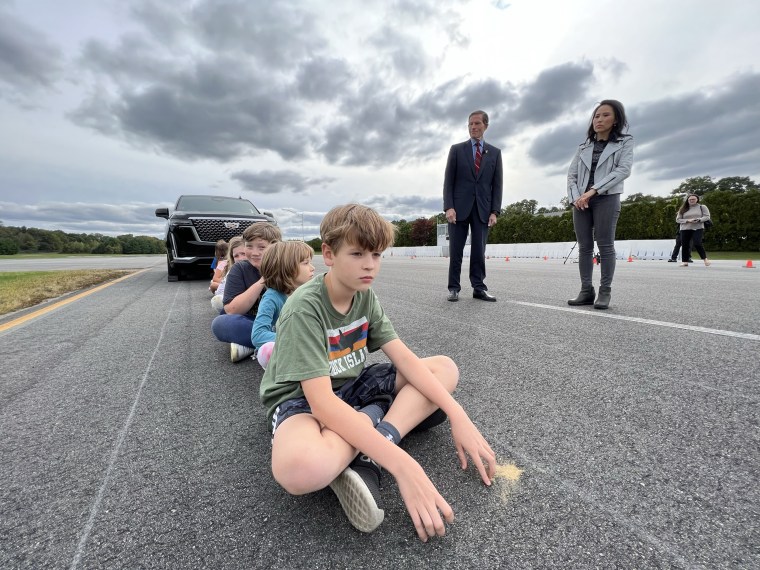The day after Christmas 2016, Jenesee Beaudoin was moving her SUV in her parents’ San Antonio driveway, preparing to pack up her kids’ presents, when she felt something under her wheels.
“It felt like I went off a curb,” Beaudoin said. As she opened the car door to see what happened, her son began screaming his younger sister’s name from the doorway. “I ran to the back of my car and there she was in between my back tires.”
Beaudoin had left her two-year-old daughter Briley in a living room full of adults. But once in the driver’s seat, she had no way to see that her little girl had wandered outside after her — right into the SUV’s front blind zone as she started the engine.
Briley died hours later at a nearby hospital.

“I had a backup camera, but I wasn’t going backwards,” Beaudoin said. “It took seconds. It’s literally seconds and someone’s life is changed forever.”
Briley was one of an estimated 64 children who died in 2016 after being hit by a forward-moving vehicle off of public roads, according to an NBC News analysis of federal crash data. More than twice as many children have died from such crashes when vehicles were moving forward than backward in recent years. An estimated 744 children were killed that way between 2016-2020, mostly in driveways and parking lots. In the majority of deaths, the child was hit by an SUV or pickup truck.
Those numbers rose sharply in 2020, and advocates worry they will continue to rise, as Americans increasingly buy large vehicles with big front blind zones instead of smaller cars with greater visibility.
Front cameras could help prevent these deaths, safety experts say. New vehicles sold in the U.S. are required to have a backup camera for rear visibility, but no such regulation exists for front blind zones. While some vehicles do come standard now with front cameras, or with front sensors that can detect obstacles and may prevent accidents, they are often expensive or luxury vehicles.
But front blind zones can extend a dozen feet or more for some of the country’s most popular vehicles, according to Consumer Reports, much further than drivers may realize. In a demonstration at the Consumer Reports Test Track in Connecticut, NBC News found it took at least nine elementary school children sitting in a line for someone in the driver’s seat of four different SUVs and pickup trucks to see the top of a single child’s head.
“I wouldn’t have believed it without doing this test. But I’m amazed, I’m appalled,” said Sen. Richard Blumenthal, D-Conn., who has championed safety legislation, after participating in the demonstration.
On Monday, Blumenthal announced legislation that would make front blind zone safety features mandatory for motor vehicles. Automakers said safety is a top priority for them and those features are increasingly available already.
“Safety should not be a matter of affordability, safety ought to be standard, and these devices can save kids’ lives,” Blumenthal said. “We ought to require them.”
Taller and heavier
Even if Blumenthal’s bill could be passed immediately, it might be two decades before those safety features are commonplace on vehicles.
After Congress passed a law to improve rear blind zone safety nearly 15 years ago, it took a decade — between rulemaking, regulatory delays and a multiyear rollout — before the rule fully went into effect. The average passenger vehicle in the country is 12 years old, so it will still be years before the vast majority of cars on the road have backup cameras.
That 2008 law also directed the National Highway Traffic Safety Administration to begin publishing data on non-traffic crashes — those that happen not on public roadways, but in places like driveways and parking lots.
That data showed that over the past 13 years, estimated deaths from forward-moving vehicles outnumbered backward-moving vehicle deaths in most years. And in the most recent five years data was available, forward-moving deaths climbed, while backward ones stayed relatively flat.
Blumenthal’s bill directs regulators to determine what technology, such as cameras or sensors, to require to make front blind zones safer, much like the rear blind zone law did.
“It’s hard to understand why we’ve known this is a problem for so long, and we’ve had this solution sitting on a shelf that’s not being used everywhere in every car,” said Amber Rollins, director of Kids and Car Safety, an advocacy group that has been pushing for rear and front blind zone protections for decades. “There’s a solution out there, and yet families continue to bury their children.”
Kids and Car Safety has tracked its own data for years on blind zone deaths, known as frontovers and backovers, gathered from news stories, police reports and firsthand accounts. Rollins has seen fewer reports of backover deaths in the years since the rule went into effect, but more frontovers, in part, she suspects, because more people are driving large vehicles.
American car buying habits have changed dramatically in the past decade. Cars make up less than half the market share they did a decade ago, while SUVs now account for half of all new vehicles sold in the U.S. Front visibility can be quite good for subcompact, compact and even some midsize SUVs, experts said. But generally, the taller and heavier the vehicle, the more limited the front visibility — and Americans are buying bigger vehicles than they used to.
Every category of midsize or larger SUV and pickup truck saw more than 20% growth in market share from 2012 to 2021, according to an NBC News analysis of Edmunds data. The most purchased new vehicle in the country for more than a decade has been the Ford F150, a large truck.
“Over time, people prefer trucks and SUVs over cars,” said Brian Moody, executive editor at Kelley Blue Book. They’re increasingly family vehicles, he said, often with larger capacities and more comfort features than the sedans and vans families primarily used to drive. “People who live in suburban and rural areas definitely have more latitude to purchase something that fits their needs, like a large SUV or a pickup.”
Front blind zone technology is increasingly important because of those trends, said Jennifer Stockburger, director of operations for the Consumer Reports Auto Test Center. “As cars have gotten bigger, visibility has gone down.”
Pickup trucks in particular, have gotten larger. Last year, Consumer Reports found that the height of a pickup truck front hood — the top of a front blind zone — grew by an average of more than 11% and truck weight went up 24% from 2000 to 2018.
“They’re heavy, and they keep getting taller and heavier,” said Stockburger. A tall, square hood is particularly difficult to see around, regardless of the driver’s height.
That’s a big safety concern, she said. “The biggest vehicles, or vehicles with the most difficulty in terms of visibility, should be prioritized to get these cameras first.”
That’s already begun, according to automakers. “Safety is a top priority of the auto industry,” the Alliance for Automotive Innovation, an industry trade group, said in a statement. “Vehicles continue to get even more safe as automakers across the board test, develop and integrate new safety technologies that can help save lives and prevent injuries.”
Invisible
NBC News examined that front visibility with a group of elementary schoolers age 6-10, and several adults of different height in the driver’s seat of four tall, square-hooded vehicles: Ford F150 and Toyota Tundra pickup trucks and Cadillac Escalade and Jeep Wagoneer SUVs. With the kids seated in a line stretching forward from the vehicle’s front bumper, it took between 9 and 11 of them before a 5-foot-2 driver could see a child’s head. Other demonstrations found similar results.

The Escalade and Wagoneer NBC News tried both had a front camera, which comes standard on the Escalade and is an upgrade feature on the Wagoneer, F150 and Tundra. When the driver tried turning on a front camera, she could see the first child clearly, instead of only the top of the last child’s head.
The Escalade and Wagoneer automakers said their vehicles also come standard with sensors that detect front obstacles. The vehicles need to be in drive for the sensors to work, so NBC News did not try them with the children. The Wagoneer’s maker said its sensors may have detected the children, while the Escalade’s maker said its sensors are designed to detect “larger objects” and would not alert the driver to “small children” or “moving people.”
The makers of the F150 and Tundra did not respond to requests for comment about their front blind zones. Parking sensors and 360-degree camera technology are not standard on either, according to Edmunds, though both include accident avoidance systems.
“If I was sitting comfortably the way I would sit in a car, I couldn’t see anything,” said Frida Berrigan, whose 6 and 10-year-old children were part of the demonstration group. “I thought, well, three kids, maybe three kids we wouldn’t be able to see. But to have a line of 10-12 kids and have them all be invisible was terrifying.”
Sen. Blumenthal, who is 5 feet 10 inches tall, could not see any of the 12 children from the driver’s seat of the Escalade with its power, including its front camera, turned off.
“It’s potentially a parent’s worst nightmare,” he said.
Jackie Foschi lived that nightmare in 2019. One afternoon, her four-year-old son Hudson got out to open their driveway gate and grab the mail. But instead of walking along behind her large SUV like he usually did, he crossed into its front blind zone as Foschi drove the last few feet up the driveway. Hudson did not survive the accident.
Foschi had chosen the SUV in part, she said, because it was one of the biggest cars she could find and she thought it would keep her kids safe near the many other larger vehicles she saw on the road around their home in Virginia Beach.
She couldn’t bear to drive the same vehicle again, so she and her husband sold it and got a car with as many safety features as they could find — a luxury midsize SUV that came with 360 degree cameras. They leased the car, an Audi Q7 that retailed for around $70,000, because they couldn’t afford to buy it.
When the lease was up earlier this year, finding something affordable with the same safety technology was challenging.

“It’s not hard to find,” Foschi said, but the 360 degree camera system she wanted was almost always part of a pricey add-on package, costing as much as $8,000 more than the base price of the car. “I don’t understand why they’re only putting them in on the highest end trim.”
Drivers can purchase aftermarket camera systems as well, but there are other steps families can take to keep children safe around vehicles with large front blind zones, according to car safety organizations. Groups like Kids and Cars and Consumer Reports recommend building habits like walking around a vehicle before starting it (which the automotive trade group said it also encourages drivers to do); making sure children are in the hands of an adult when someone is leaving or arriving; and teaching them about the dangers of vehicles and how big blind zones can be.
Foschi’s family has made a lot of those and other safety adjustments since they lost Hudson nearly four years ago. But she believes the best way to prevent future tragedies is widespread use of blind zone cameras.
“I just would love to not see another parent have to go through what our family and so many others are going through,” she said. “The technology is there, it’s available. … I just don’t know why safety isn’t standard.”
Source: | This article originally belongs to Nbcnews.com










